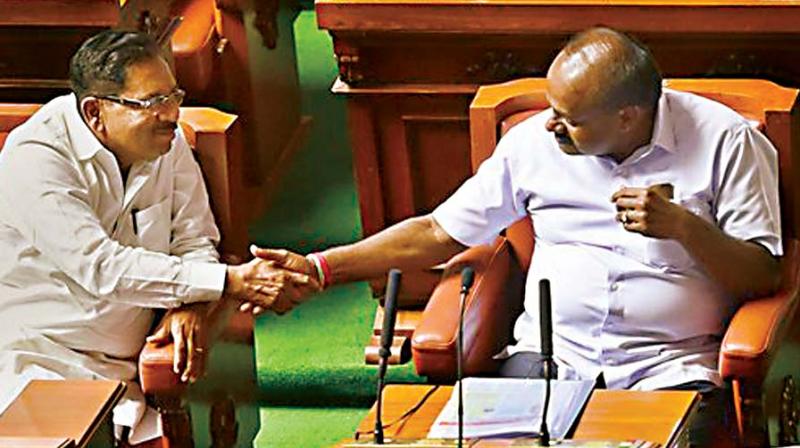Unless caste voting stops, no stable govts in Karnataka
The identity-based voting exists even in other social groups, but not as ferocious as it has been in these two social groups.

The 2018 Assembly election results of Karnataka did not give a simple majority to any political party. After the BJP’s futile attempt to form the government, the Janata Dal (Secular)-Congress combine formed the government and proved its majority. However, this post-poll coalition, as indicated by news reports, will be marred by unreasonable demands for positions of additional deputy CMs, ministerial berths and offices of profit, rotation of CM between the JD(S) and Congress and the resultant internal bickering. All this would severely affect the government in delivering on development in Karnataka. It would have been much better for Karnataka if there was a simple majority government, irrespective of which party forms the government, rather than post-poll alliances of different hues. First things first. If anybody has a notion that the fractured mandate is a new phenomenon in Karnataka, they are mistaken. The electorate of Karnataka has been giving fractured mandates since 2004. In the 2004 Assembly election, the Congress, BJP and JD(S) secured 65, 84 and 58 seats respectively. As a result, between 2004 and 2008, Karnataka witnessed three chief ministers, Dharam Singh under the Congress-JD(S) alliance, H.D. Kumaraswamy under the JD(S)-BJP alliance, B.S. Yeddyurappa’s seven-day rule under BJP-JD(S) alliance (the JD-S did not support Mr Yeddyurappa’s government despite its promise to hand over the CM position to him) and two interregnums of President’s rule, and severely inflicted the administration of Karnataka.
The Assembly election in 2008 also resulted in a fractured verdict, with the BJP securing 110 seats, three seats short of a majority. The BJP’s effort to gain a few more seats to get a simple majority resulted in unholy relationships and created huge confusion in the state’s administration and the party’s image too. Karnataka had to witness three chief ministers — Mr Yeddyurappa, D.V. Sadananda Gowda and Jagadish Shettar — all from the BJP, between 2008 and 2013. Although for the record the 2013 Assembly election gave a simple majority to the Congress; it was truly a fractured mandate. If the votes secured by Mr Yeddyurappa’s Karnataka Janata Party and B. Sriramulu’s Badavara Shramikara Raitara Congress Party (BSRCP) were included — which are breakaway parties of the BJP — the Congress, BJP and JD(S) should have got 92, 86 and 40 seats in lieu of 122, 40 and 40 seats respectively. In fact, the breakaway factions of the BJP helped the Congress in securing a simple majority. The 2018 Assembly election too threw hung Assembly with 104, 78 and 38 seats for the BJP, Congress and JD(S) respectively, and the BJP was short of a majority by eight seats. The moot question is why Karnataka has been giving fractured mandates since 2004? Karnataka has been witnessing very serious identity-based voting for decades, even outdoing Bihar and Uttar Pradesh. However, it did not result in fractured verdicts till 1984 as there was no major party to challenge the Congress or Congress (I). Once parties such as the Janata or BJP emerged as challengers to the Congress, identity-based voting started giving fractured mandates.
It is common sense that a political party cannot and will not enjoy the same level of support across gender, age, education levels, income levels, social groups, urban and rural areas and different geographical regions, and hence variations in support for a political party are very much acceptable. (For instance, till her death, J. Jayalalithaa enjoyed 10 per cent more support among women than men.) However, the variations must broadly align with the general mood of the electorate of the state. However, this has not been happening in the Karnataka elections since 2004. For instance, in 2018, various opinion polls, exit polls and actual results show that more than 60 per cent of Vokkaligas, Lingayats and Kurubas voted for the JD(S), BJP and Congress respectively, whereas they secured 18.3 per cent, 36.2 per cent and 38 per cent votes respectively. Take the case of Vokkaligas. They want their man to be at the helm all the time. Although the JD(S) is a national party in theory, once it decided to give its top leadership only to Deve Gowda family members, it became Gowda & Sons and has appeal among Vokkaligas. Since the JD(S) alone provides such opportunity for Vokkaligas, no other party or no other Vokkaliga leader from the Congress or BJP is palatable to them, whether it is Congress CM S.M. Krishna or BJP CM D.V. Sadananda Gowda.
National parties such as the Congress or BJP cannot declare a candidate from one specific social group all the time or cannot make someone from a specific social group as CM all the time, and thereby national parties belie the expectations of Vokkaligas. As a result, irrespective of the performance of incumbent governments, Vokkaligas continue to vote for the JD(S) in large numbers and as a result the JD(S) could always secure 30 to 40 seats in the Vokkaliga-dominated old Mysuru region. Then comes the Lingayats. The BJP not only accommodated Mr Yeddyurappa after he floated a party of his own that decimated the BJP in the 2013 elections, but also anointed him as the state BJP president two years ago, and declared him as the Karnataka’s CM candidate before the elections. This is unusual for the Narendra Modi-Amit Shah duo, as the BJP had gone into many Assembly polls without even declaring CM candidates. Although Mr Yeddyurappa reached 75, the unofficial upper age limit for ministerial positions and the image of Mr Yeddyurappa has not been so great in Karnataka, the BJP still went on to declare him as the CM candidate.
It is true that Mr Yeddyurappa is a core RSS man and nurtured the BJP at the grassroots for decades, and hence one of the tallest leaders of BJP in Karnataka. However, more than his contribution to the RSS and BJP, his social identity played a key role in announcing him as the CM candidate of the BJP. Because the BJP learnt its bitter lessons in the 2013 Assembly election by not having Mr Yeddyurappa on its side and lost nine per cent of its vote base to the KJP, leaving the BJP with 20 per cent voteshare. The BJP central leadership knew that had it not declared Mr Yeddyurappa as its CM candidate, its chances were much less as large sections of Lingayats would not vote for the BJP. The BJP, which wants to have its support based across states and various strata of people, had to surrender before the identity-based voting preferences of Lingayats in Karnataka.
The recent addition to this identity-based voting pattern is Kurubas. With Siddaramaiah reaching the helm of Karnataka, Kurubas consolidated themselves to vote on social identify and voted for the Congress in large numbers in 2018. However, this would be shortlived since Mr Siddaramaiah was no longer to be at the helm of affairs. The concentration of Vokkaligas and Lingayats in specific regions has been enabling them to exercise their franchise on social identity. The identity-based voting exists even in other social groups, but not as ferocious as it has been in these two social groups. As many of the other social groups are spread thin across the state, they have little scope to tamper with the election results even if they chose to cast their votes on social identity. Given that Lingayats and Vokkaligas constituted about 17 per cent and 11 per cent of the total electorate of Karnataka, the identity-based voting pattern of these social groups has been causing fractured verdicts and holding Karnataka to ransom. Unless this pattern changes, there is no reason to believe that Karnataka would get a clear mandate in one or other way in future Assembly elections too.

